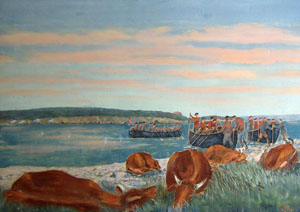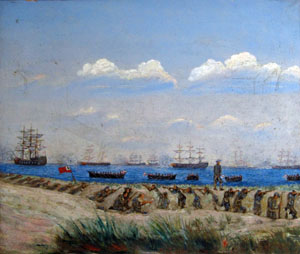Historical Paintings of Woods Hole and Falmouth by F. L. Gifford

Foraging by the British in Little Harbor, Woods Hole, and the Battle of Falmouth, 1779
Foraging by the British, April 1, 1779
[The first] painting portrays a typical forage by the British in Revolutionary times.
Early in the morning of April 1, 1779, the British landed on the shores of Little Harbor and proceeded to steal twelve head of cattle from nearby farms. They drove them down to the shore and knocked them in the head. The British were about to land the animals aboard their boats when they were fired upon by some of the Minutemen who had been sent there from Falmouth and other nearby towns to repulse this foraging party. So fierce was the fire of the Americans that the British had to abandon their loot, and sailed off empty-handed.
The Battle of Falmouth, April 2, 1779
On April 2, 1779, a fleet of ten British men-of-war sailed over from Tarpaulin Cove, Naushon Island, to raid and burn the town of Falmouth. They had anchored for the night in Tarpaulin Cove, and some of the officers had gone ashore to the tavern kept by a John Slocum. Their host overheard them discussing their plan to attack Falmouth, and though a Tory, Slocum could not see Falmouth burned without giving warning. So he sent his son down to the island, and across to Woods Hole to spread the news.
At daybreak, when the British fleet appeared off Falmouth, they were surprised to find trenches dug on the shore near the Old Stone Dock, (on the present Surf Drive,) and a force of two hundred men ready and waiting.
Finding this determined body of defenders led by Colonel Dimmick, ready to put up a formidable argument, the British decided not to even try to land. From their ships they carried on a cannonade from about eleven in the morning until dark. However, owning to the weather, their fire was very ineffective, as it was the period of an April thaw and the cannon balls did not rebound. Several houses were hit but comparatively little damage was done. The following morning the British fleet sailed away.
([Gifford’s] note: The gallant, fearless figure of the officer shown in the painting, who is mounted on the top of the parapets on the shore is none other than the picturesque Falmouth officer in the Revolutionary War, Colonel Joseph Dimmick. About 1774, Joseph Dimmick of Falmouth was recognized as a many with exceptional qualities of leadership. He was a man with nerves of steel, a courageous and zealous patriot. Under his training and leadership, the Falmouth body of Minute Men was organized and made a most effective military organization.)
The description of the British forage is from Historical Paintings of Woods Hole, by Franklin Lewis Gifford (Woods Hole Public Library, 1962). The description of the Battle of Falmouth is from Historic Woods Hole, by Franklin L. Gifford (1932).

